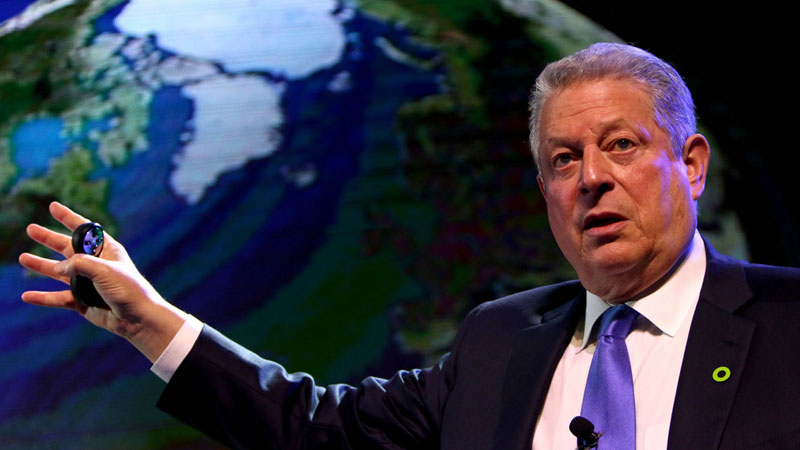Gore warns PH of looming disaster

BOMB DROPPED Former US Vice President Al Gore, an environment advocate, likens the effects of climate change to the Hiroshima and Nagasaki bombings in his speech before delegates of the Climate Reality Leadership Corps Training. RICHARD A. REYES
WHAT will an increase of 1 degree Celsius in global temperatures mean for the Philippines?
In an exclusive interview with the Inquirer, Al Gore gave a bird’s eye view of the projected impact in the Philippines should temperatures continue to rise despite the 2-degree limit in carbon emissions set by the Paris Climate Accord in December 2015.
“We are seeing the loss of endangered species. Already, the Philippine eagle is endangered,” Gore said.
A Nobel peace laureate and global climate activist, Gore is in Manila to preside over the three-day “Climate Reality Leadership Training Corps,” which started Monday.
Mincing no words, Gore declared that 50 percent of all living species on the planet, including endemic birds in the Philippines, would be lost in a century “if we don’t arrest this dangerous trend.”
Article continues after this advertisementHe was referring to the warming of the planet through the continued use of carbon dioxide (CO2), the chief contributor to greenhouse gases, that traps excess heat in the atmosphere which, in turn, triggers global warming.
Article continues after this advertisementGore said 2015 was the hottest year, and last month was the 372nd consecutive month with a global temperature higher than the 20th century average.
“We are already reaching extremes that really should set off alarm bells,” he said.
“Already, the plant and animal species of the world are moving toward the pole in an average of 15 feet per day. Everyday. Microbes are moving also, and those that are carried by mosquitoes and ticks are becoming more threatening to human beings,” he said.
Gore cited the spread of the Zika virus as the latest of many relatively new microbial threats spawned by extraordinary heating of the planet.
“That should give us pause because the relationship with humanity and the disease-carrying microbe is mediated by climate. We have the upper hand when the nights are cooler, and of course immunities are different in tropics, subtropics (regions),” he said.
“But the threat is the same everywhere, and you have now a much bigger threat from dengue and chikungunya, and some of the other diseases that were held back,” he said.
“And the list of these problems is a long one,” he stressed.
Close to danger zone
Gore provided these projected scenarios on the impacts of the increase of 1 C in global temperatures when asked how important was it for the world to abide by the Paris agreement to keep temperatures well below 2 C.
Gore, who actively took part in the Paris climate negotiations, noted that there was an agreement toward keeping a lid on temperature increase by trying to limit it even further to 1.5 C above preindustrial levels.
Compliance with the Paris agreement is “very important,” he said.
“I am so happy that the 2-degree goal was modified with the reference to 1.5 (degrees). One way to think about this is this: We have already seen an increase in just about 1 degree, and the north polar ice caps are melting rapidly, the land-based size on Greenland and Antarctica is beginning to melt much more rapidly, sea level is rising,” he said.
“We are getting closer to the danger zone with the melting of the arctic permafrost that could release a lot of methane emissions that are even more dangerous than CO2,” he added.
‘Playing with fire’
He noted that all of these threats that the world was beginning to see were emerging and getting worse with only a 1-degree increase in temperatures.
“So [for] 1.5 degrees, we’re playing with fire. And of course it’s almost unimaginably difficult to change because 85 percent of world’s economy comes from burning fuel. But we have to change. And the good news is we can change, we have this new technology that is good for us. And the only remaining question is will we change?” he asked.
Gore acknowledged that Filipinos had a firsthand experience with the disastrous effects of climate change in 2013, when Supertyphoon “Yolanda” (international name: Haiyan) inundated Eastern Visayas, displacing over a million families.
He predicted that these superstorms were “likely to come stronger still with the continued warming of the oceans.”
Risk to food security
During his presentation Monday at the training program, Gore noted that rice, corn, maize and cassava would be impacted by climate change.
According to him, rice yields will be affected by nighttime temperatures, while cassava would be affected by the increase in plant pests, with the cassava’s nutrients diminished by the high concentration of CO2.
“In the Philippines, [there’s] risk to food security as a result of the climate crisis,” said Gore.
Gore explained that the sea level was rising faster in the Philippines mainly because of thermal expansion and the melting of ice in Greenland and Antarctica.
Gore described this combination of higher sea levels and more powerful storms a “double whammy” for island-nations like the Philippines.